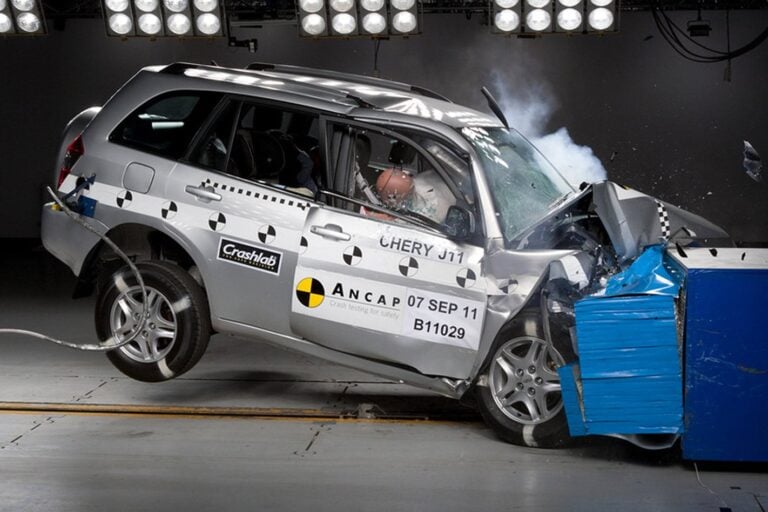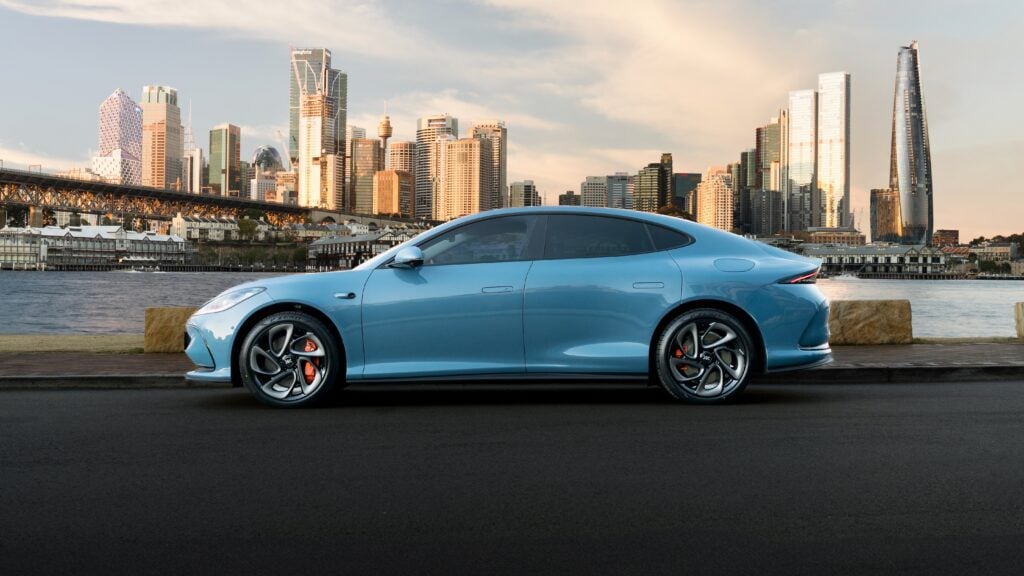
Car buyers rely on safety ratings as a factor to make an informed major purchasing decision, but the design of crash test dummies generally don’t represent most female bodies.
Key Points
- ‘Hybrid III’ dummy represented 5% of females when developed in 1988
- Based on male dummy model, which covers 50% of population
- Carmakers & safety authorities working to improve representation for all bodies
Women tend to be smaller and lighter than men, with different torso, hip, and pelvis shapes – resulting in a different seating position.
A study from the National Highway Traffic Safety Administration [↗] revealed that women could be three times more vulnerable to whiplash injuries in the event of a rear vehicle impact.
According to the Australasian New Car Assessment Program (ANCAP), it has used two ‘Hybrid III’ fifth-percentile female dummy models in the full-width frontal test (driver and rear outboard passenger seats) since 2018. It forms part of its ‘adult occupant protection’ testing category.

Only five per cent of females in Australia were smaller than the 152cm, 45kg dummy when it was first developed in 1988.
In contrast, the related Hybrid III 50th-percentile male model represents the average male population at 175 centimetres and 77.7 kilograms.
Speaking with WhichCar, an ANCAP spokesperson said the organisation uses different dummies for each test, based on “real-world crash population and worst-case scenarios” and the results aren’t limited to one gender or body type.
“The smaller occupant tends to be the more difficult to protect as they sit closer to the steering wheel and have a lower pelvis height that is more likely to ‘submarine’ beneath the lap belt,” the spokesperson said. “On this basis, the fifth-percentile female dummy is chosen.”

“It is not realistic to test all crash types for all occupant sizes, as this would be cost prohibitive”
“Female drivers have tended to be over-represented in intersection side impact crashes, [but] currently there is not a suitably advanced small female side-impact dummy available. There has been an ongoing international project to develop a smaller version of the WorldSID dummy, but this remains incomplete and so the 50th [percentile] male dummy is used.
“It is not realistic to test all crash types for all occupant sizes, as this would be cost prohibitive – but our choice of test tools aims to give the best safety outcome for the broadest range of occupants.
“As new tools and methods become available, we will continue to review the appropriate choice for each test.”

Male-orientated design
According to the Insurance Institute for Highway Safety (Discover Magazine [↗]), ‘Sierra Sam’ was the first crash test dummy, developed in the 1940s for the United States Air Force to help protect pilots – with male body norms at the time.
Dr Maureen Engel, an academic and lecturer in digital culture at The University of Queensland, said female dummies today are adapted from male models.
“The crash test dummy itself was a marvellous innovation in safety and the initial model was based on the average proportions of a North American man,” Dr Engel told WhichCar.

“That is a common problem in a lot of design, engineering [and medical] environments, where the male subject is taken to be the norm – and then women are the bodies that are ‘different’.
“What happens over time is a whole kind of system builds around these technologies… there are children, people who are very short or very tall, and all kinds of outliers where being able to account for them becomes a problem rather than a requirement.
Dr Engel described this as a “a specific example of a broader issue that’s [also] a very common cultural phenomenon”, highlighting the importance of recognising that these unintended but common biases “happen on many different levels on body size, gender, age and physical ability”.
“We design all sorts of things with very specific bodies in mind, and that can be tremendously disadvantageous to many different kinds of people.”

Improving representation
Data from the Australian government [PDF ↗] shows that the majority of drivers involved in a fatal accident between 2012 to 2021 were male – but female occupants are still more likely to be killed in a vehicle accident.
According to Green Slips [↗], around 52 per cent of Australian licence holders are female.
The discrepancy isn’t for a lack of effort on the part of manufacturers, either. Carmakers conduct internal safety tests when developing new models to ensure they comply with global safety standards – but a spokesperson for Skoda’s head office in the Czech Republic told WhichCar that carmakers and independent safety authorities are currently limited to two key anthropomorphic dummy suppliers: Humanetics and Kistler.

“The test dummies are mainly measuring devices that contain a lot of sensors… For each type of dummy, based on the injury risk curves, the biomechanical criteria [are] set up. They take into account gender and age, and the severity of the injury. The body proportion doesn’t play [an] important role.”
The spokesperson said that Humanetics and Kistler are “continuously” working on new biofidel devices (the formal name for crash test dummies), and a new model – THOR-5F (47.3kg) – is in the works to replace the Hybrid III fifth-percentile female dummy introduced in 1988.

“From 2027, consumer organisations like Euro NCAP will use the THOR-5F, and define new biomechanical criteria. There are also activities to create and take into account the pregnant, elderly or obese crash test dummies (123.8 kg), in order to cover [the] whole diversity of the population,” the Skoda spokesperson said.
Sounds like a solution is around the corner? Not quite. While THOR-5F is technologically more advanced for authorities to better assess frontal impact test results, it is still fifth-percentile female and is based on the 50th-percentile male model (THOR-50M), reducing its value beyond the current Hybrid III model.
And locally?
In 2020, ANCAP introduced THOR-50M to its family of dummies, which includes a range of other models to assess side impact crashes, child occupant protection, and active safety assistance systems.
There’s hope, but it won’t come cheap
While this all suggests there’s little promise of improvement in properly assessing female vulnerability in a crash, there is some hope with the first ground-up female car crash test dummy developed in late 2022 by the Swedish National Road and Transport Research Institute.
For now, the 162cm, 62kg dummy remains just a study model and isn’t yet available to crash test organisations, it claims to reflect the same dimensions as an average woman today.
However, there may be only a small likelihood that crash test organisations will upgrade to this new model even when it’s made available: according to Skoda [↗], the industry’s existing dummies are made up of replaceable individual parts to mimic the human body, so they effectively have an unlimited lifetime.
Exacerbating this, the high price tag – up to AU$1 million (€650,000) for the existing THOR-50M model – means dummies are more often repaired than replaced.
Accurate female representation in crash testing, therefore, will likely remain low for the foreseeable future.
We recommend
-
 News
NewsBaby seat recalled after shocking crash test fail
The $600 Joie seat had been on sale for a year after meeting Australian Standards
-
 Advice
AdviceANCAP car crash test ratings explained
The way Australia scores cars for crashworthiness has been through a seven-year transition. We track down what’s changed
-
 Opinion
OpinionWhy half the population is more likely to die in a car crash
The way we use crash test dummies means half the population is 17 percent more likely to die in a vehicle accident




